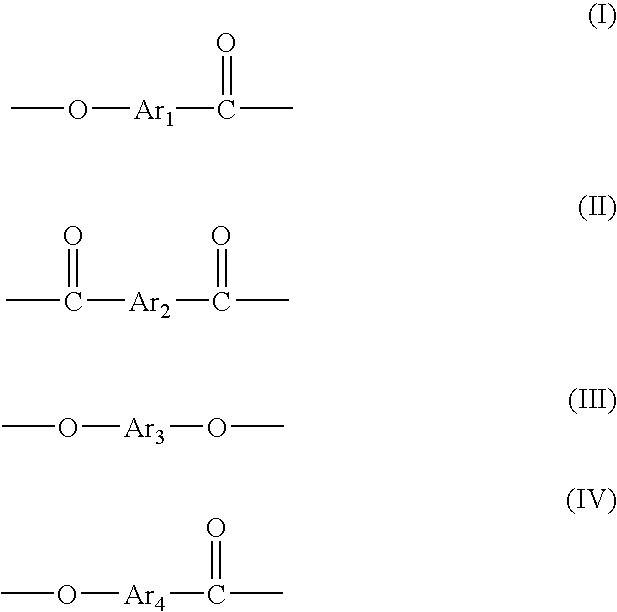Wholly aromatic polyester and polyester resin composition
a technology of polyester resin and aromatic polyester, which is applied in the field ofwholly aromatic polyester, can solve the problems of polyester having problems in relation to heat resistance and melt-processability, unable to maintain mechanical strength at high temperatures (temperatures lower than but close to melting point), and unable to achieve good flowability, excellent thermal stability
- Summary
- Abstract
- Description
- Claims
- Application Information
AI Technical Summary
Benefits of technology
Problems solved by technology
Method used
Image
Examples
example 1
The following monomers as raw materials, metal catalyst and acylation agent were charged into a polymerizer equipped with an agitator, a reflux column, an inlet for introducing nitrogen and a decompression / discharge line, and the inside of the polymerizer was then substituted by nitrogen.
(I) 166 g (48 mol %) of 2-hydroxy-6-naphthoic acid (HNA)
(II) 76 g (25 mol %) of terephthalic acid (TA)
(III) 86 g (25 mol %) of 4,4'-dihydroxybiphenyl (BP)
(IV) 5 g (2 mol %) of 4-hydroxybenzoic acid (HBA)
22.5 mg of potassium acetate catalyst
191 g of acetic anhydride
After the raw materials were charged into the polymerizer, the temperature of the reaction system was increased to 140.degree. C. and the contents of the polymerizer were allowed to react at 140.degree. C. for 1 hour. Thereafter, the temperature of the reaction system was further increased to 360.degree. C. in 5.5 hours. Then, the internal pressure of the polymerizer was reduced to 5 Torr (or 667 Pa) in 30 minutes, and melt polymerization ...
example 2
A polymer was obtained in the same manner as in Example 1 except that the amounts of the raw materials were changed as follows.
(I) 186 g (54 mol %) of 2-hydroxy-6-naphthoic acid
(II) 68 g (22.5 mol %) of terephthalic acid
(III) 77 g (22.5 mol %) of 4,4'-dihydroxybiphenyl
(IV) 3 g (1 mol %) of 4-hydroxybenzoic acid
22.5 mg of potassium acetate catalyst
190 g of acetic anhydride
example 3
A polymer was obtained in the same manner as in Example 1 except that the amounts of the raw materials were changed as follows.
(I) 140 g (40 mol %) of 2-hydroxy-6-naphthoic acid
(II) 83 g (27 mol %) of terephthalic acid
(III) 94 g (27 mol %) of 4,4'-dihydroxybiphenyl
(IV) 5 g (6 mol %) of 4-hydroxybenzoic acid
22.5 mg of potassium acetate catalyst
194 g of acetic anhydride
PUM
| Property | Measurement | Unit |
|---|---|---|
| melting point | aaaaa | aaaaa |
| softening temperature | aaaaa | aaaaa |
| melting point | aaaaa | aaaaa |
Abstract
Description
Claims
Application Information
 Login to View More
Login to View More - R&D
- Intellectual Property
- Life Sciences
- Materials
- Tech Scout
- Unparalleled Data Quality
- Higher Quality Content
- 60% Fewer Hallucinations
Browse by: Latest US Patents, China's latest patents, Technical Efficacy Thesaurus, Application Domain, Technology Topic, Popular Technical Reports.
© 2025 PatSnap. All rights reserved.Legal|Privacy policy|Modern Slavery Act Transparency Statement|Sitemap|About US| Contact US: help@patsnap.com



